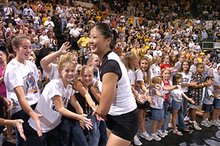Friday, May 18, 2007
Wednesday, May 16, 2007
True Sons: The Arrival
Read about the birth of a Big Eight dynasty here.
The first call came from St. Louis, the second from Kansas City. By the time Norm Stewart put down the phone, he knew his program was about to take a giant leap forward, but he did his best to contain his joy. "We're very pleased with both Steve and Jon," he said in an act of staggering understatement. He had just received commitments that would change the course of Missouri basketball.
Tuesday, May 15, 2007
Monday, May 14, 2007
True Sons: The Legend of John Brown
Today's excerpt takes us back to the 1972-73 season when the Tigers moved into the Hearnes Center and big farewell to John Brown, the first superstar of the Norm Stewart era.
The new building featured a space-age Tartan floor, an exotic gray court that the players loathed. The rubbery surface prevented them from sliding, and it dampened sound such that they could not hear the ball bounce, a disorienting experience for players who grew up on hardwood. Despite the new environment and crowds often well below the 12,600 capacity, the Tigers maintained the home-court edge that had become a hallmark of the Stewart era and rode it to the best start in half a century. Against Ohio, before a packed house, John Brown christened the building with a midrange jumper, and he and five other Tigers—Al Eberhard, Mike Jeffries, Orv Salmon, Gary Link, and sophomore Felix Jerman—tallied double figures. Attendance dropped sharply after opening night. Only 7,714 fans saw Brown collect thirty-five points and fifteen rebounds in a win over Purdue that moved the Tigers to 4–0.
Friday, May 11, 2007
Thursday, May 10, 2007
True Sons: Breaking the Barrier
Today's excerpt takes us back a half century, to when Al Abram stepped on to the basketball court and and forever changed the University of Missouri.
It was the start of a long, slow fade for Sparky Stalcup. In his first ten years at Missouri, his teams finished second in the conference five times. But after Norm Stewart's graduation, they would never again place higher than fourth. Though his clubs were not devoid of talent, Stalcup could not match the enormous firepower that found its way to Lawrence and Manhattan. Part of that was due to his personal fabric. When it came to recruiting, Stalcup was ethical to a fault and even a bit naïve to the way the game was changing. He believed to his core that basketball should be just one piece of the university experience. He believed in students who played basketball, not basketball players who dabbled in education. "A school like Missouri will not relax its educational requirements for the sake of getting an exceptional athlete," he said. "The era of the dumb athlete is fast drawing to a close." He abhorred the corrupt recruiting practices that became more prevalent in the 1950s and railed against them. He believed that under-the-table payments were being made to the best big men, the kinds of players that were changing the game. He blamed alumni for brokering deals and blamed coaches for turning a blind eye. He feared for the integrity of the game.
Wednesday, May 9, 2007
Tuesday, May 8, 2007
True Sons: Meanwell Arrives
Today's excerpt takes us back to the 1917-18 season, when a charter member of the Basketball Hall of Fame arrived in Columbia and laid a foundation that would help make the Tigers the nation's best team over the ensuing six-year span.
Monday, May 7, 2007
True Sons Excerpt: The First Tigers
Friday, April 27, 2007
Quick Hits
One of the world’s worst-kept secrets was confirmed this week, when it was announced that Glen Dandridge has left Mizzou’s basketball team. As much as you can be happy for someone in a situation like this, I’m happy for Glen, who by all accounts is a great kid, and (as a basketball player, at least) needs a change of scenery as much as anyone I can remember. After Dandridge signed with Mizzou, a prominent recruiting analyst raved to me about Glen’s shooting range, and people inside the program have long been impressed with his play in off-season workouts and pre-season practices. But it just never happened for him at game time. In three seasons in Columbia, Dandridge never got hot from three-point range. And that’s not hyperbole. It just never happened, not even once, which is amazing (if you need evidence, I can produce the numbers). Here’s hoping he can find a place where he can relax, finish his degree, make a lot of shots, and be at home and happy.
Dandridge’s departure opens a scholarship and raises the question of how, if at all, the Tigers fill it. Suffice it to say, it’s hard to find impact players come late April (there are a few rumors, ranging from credible to less so, about who the staff might be pursuing), but given the fact that six more scholarships open up a year from now, it sure would be nice to find a player now. That said, there’s no point in committing to a player with only slight prospects of helping the team. If the staff can’t find the right player, I hope they’ll consider rewarding senior walk-on Nick Berardini with a scholarship in his final season. Berardini gives maximum effort for minimum glory, and he may be the most enthusiastic guy I’ve ever seen on Missouri’s bench.
Noted without comment: “[Brandon Rush] said over the weekend the classes he takes now are ‘easy,’ but he has run out of easy ones.”
I had a great time speaking to the Cass County Alumni Chapter last night, and the event reaffirmed to me the obligation I had to be accurate with Missouri’s basketball history in the book. People remember. One gentleman wanted to talk about Redford Reichert, who played for the Tigers in the middle 1950s. Another recalled the injury that Mizzou center Bob Allen suffered in 1971. Yet another remembered watching Missouri teams coached by George Edwards. Edwards, for the uninitiated, retired in 1946.
Posted by
Michael Atchison
at
11:01 AM
|
![]()
Labels: Kansas basketball, Mizzou basketball, True Sons
Tuesday, March 6, 2007
Late Night Hoops Talk on KMOX
I'll be on the Mark Reardon Show on KMOX (1120 AM in St. Louis) on Wednesday night at 11:15 p.m. to talk Mizzou hoops history on the eve of the Big 12 Tournament. You can listen over the air or on-line at kmox.com.
Monday, March 5, 2007
Shameless Plug Alert
I'll be selling and signing copies of True Sons on Tuesday, March 6, at the Kansas City Tiger Club's final regular meeting of the spring. It's at noon at Lidia's in the Freighthouse District near Crown Center (roughly 22nd and Baltimore).





